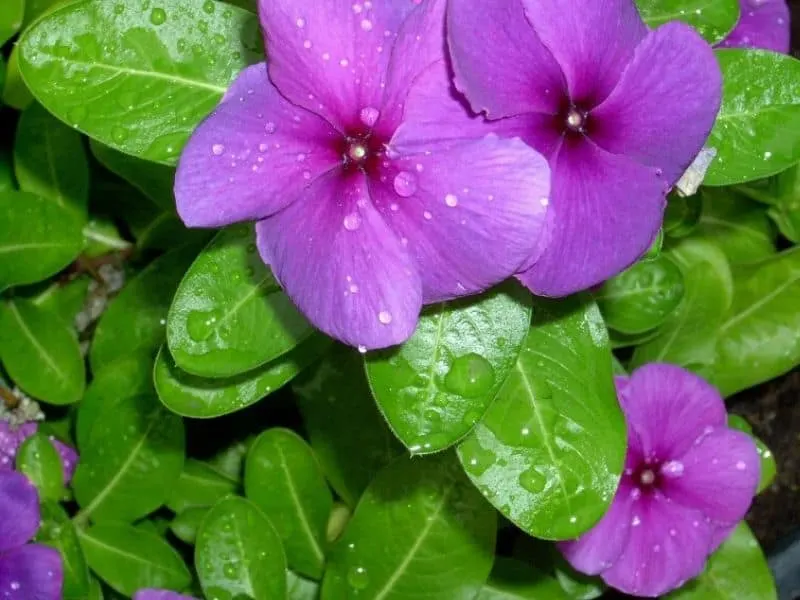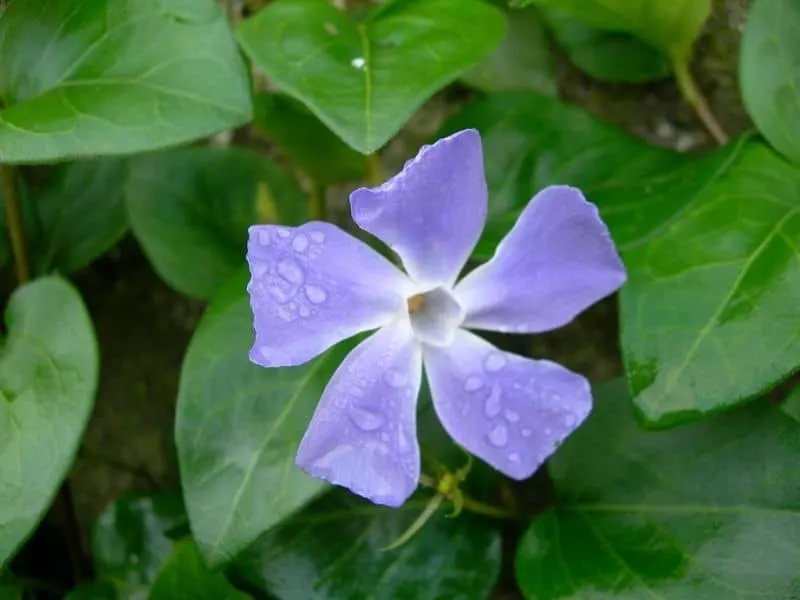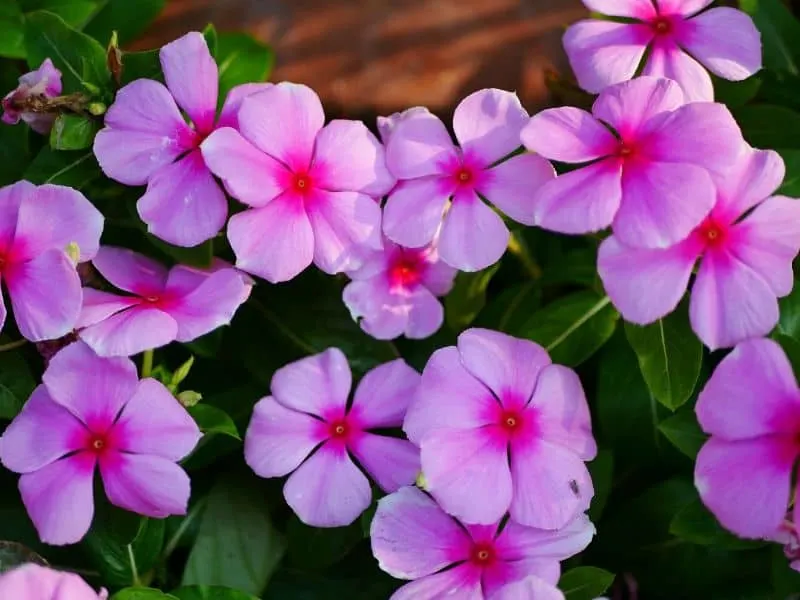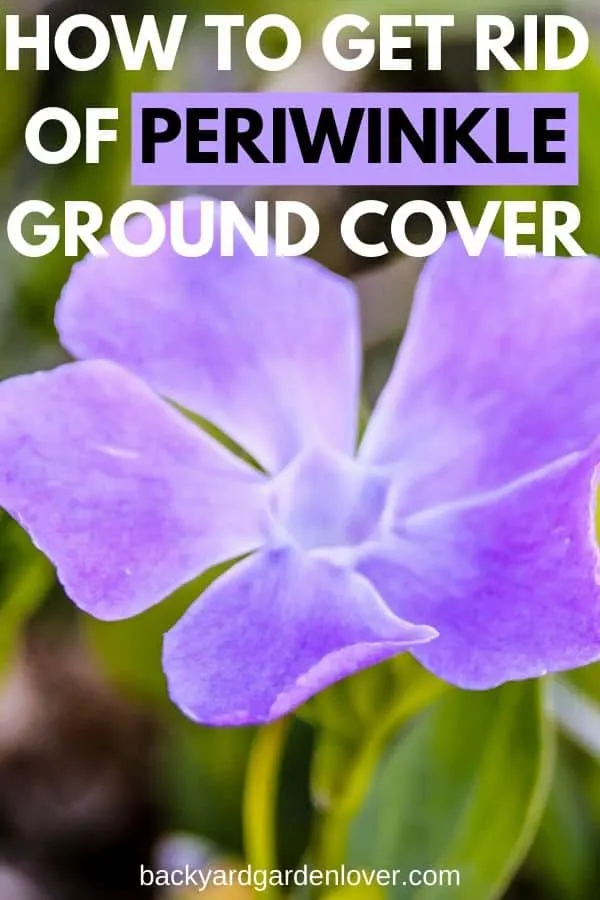Periwinkle, also known as Vinca major, makes a beautiful ground cover that doesn’t require much attention. That’s until it takes over your entire yard (and probably the neighbor’s). If you find your yard overtaken by these pretty purple flowers, you’ll be glad to learn how to get rid of periwinkle.

What does Vinca major look like?
If you don’t know what the periwinkle plant looks like, these pictures will be helpful. With dainty soft purple or blue flowers and waxy-looking leaves, the periwinkle plants look pretty but are quite invasive in many parts of the country.
Most periwinkle flowers are light purple or lavender colors.

But there are some other colors as well, like these pink beauties.

How To Get Rid Of Periwinkle Ground Cover
If you’re one of those people who got excited and planted this ground cover only to discover that it invaded your entire backyard, or you inherited a periwinkle-covered property, these tips will help you get rid of it.
I’ll tell you now: it won’t be easy. Vinca major can be a real pest! But with some perseverance, you’ll be able to win this battle.
Here’s how to get rid of unwanted plants in your garden.
Pull periwinkle plants by hand
This is one of the better methods of killing Vinca, but also the most time-consuming. It can take years to completely remove it from your property!
The roots are about 6″ deep and you’ll need to pull and then bag everything you pulled in plastic bags, or burn them. Otherwise, any piece of the plant is one more way to spread.
Use garden gloves when pulling vinca runners out by hand to protect your hands from blistering.
You may be inclined to take a weedwhacker or a mower to your periwinkle patch. Don’t do it! You’ll be sorry you did.
Just take your time and pull one plant at a time. Ask family and friends to come help: make it a party with some music and pizzas to keep you going.
Remove all loose pieces of periwinkle from the area, and either burn them or dispose of them in a black plastic bag. And NEVER add this plant to your compost pile!
Deplete the periwinkle weed roots of sun
This method works well in conjunction with the manual removal method.
Once you clear the area as much as possible, cover it with a black tarp or plastic. It will not get any sunlight and after a few weeks will be dead. Make sure to secure it well with rocks, logs, or whatever it takes. Don’t let any light go to the leftover roots of the plant. Leave the plastic on for at least 6 weeks. But it might be better to leave it on for several months, just to make sure those roots are dead.
Better yet, gather up some large cardboard boxes (from big appliances like refrigerators and stoves). Remove any packing tape from the boxes. Lay the cardboard on the ground where you manually removed as much of the vinca as possible. Overlap adjoining sheets by at least a foot, to make sure no new growth can find its way between 2 pieces of cardboard.
Cover the cardboard with about four inches of wood mulch. Let it be for a couple of years, adding more wood mulch as needed to keep the area looking tidy. The rain will help the cardboard decompose, and the vinca vines will die because of a lack of light and air.
A long time to wait, but worth it.
Use an herbicide to kill periwinkle ground cover
While herbicides are not my favorite, if you have a lot of periwinkle vines to kill, you might be forced to use them.
If you have a big area covered in Vinca plants and want to kill the vines but not the surrounding vegetation, consider 3-4% triclopyr 4 with a good surfactant sprayed during the dormant season when most natives are safe underground. It needs to reach a high temperature of ~50 degrees for the herbicide to be effective, so look for one of those warm winter days.
But the best time to apply this herbicide is in late spring, just as the plants start to come to life and grow rapidly after the winter season.
The fastest way to kill periwinkle weed
This method might be a bit extreme, but in some cases, necessary. It’s the fastest but most expensive way to get rid of periwinkle in the garden.
Hire someone with an excavator, and ask them to dig a foot of earth where the periwinkle is. Once all of the vines are gone, get rid of the old soil and refill the area with clean dirt.
No that you got rid of the periwinkles, do you wonder what you can use in their place? Try planting creeping phlox: it comes in many colors and will create a beautiful ground cover.
But what if you LOVE the vincas?
There’s no doubt about it: vinca flowers are gorgeous! Especially if you combine the many varieties that are available.
Outsidepride Periwinkle Bright Eyes – 2000 Seeds Easy to grow Vinca Sunsplash Mix 50 Seeds
Easy to grow Vinca Sunsplash Mix 50 Seeds Periwinkle Ground Cover Plant Flower Seed Mix – 2000 Seeds
Periwinkle Ground Cover Plant Flower Seed Mix – 2000 Seeds
No worries! you can still enjoy periwinkle flowers on your patio. Since they don’t really set seeds, you can plant them in a container on your back porch and enjoy lovely shows of color all summer long 🙂
Or, if you have an area with clay soil, you can plant periwinkle there. Here are more ground covers that thrive in clay soil.
You can also create your own upside-down vinca planter. Ankit shows how to make it in the video below:
https://www.youtube.com/watch?v=nOBlJwtsqPs
I hope you can now get rid of the periwinkle from your yard, but you’ll still enjoy it on your patio or in a hanging basket. I love it when I can have it both ways 😉





27 Ground Cover Plants For Clay Soil You'll Love
Thursday 3rd of August 2023
[…] Vinca can be invasive in some parts of the country, so check before you plant. If you got it and it’s taking over your yard, here’s how to eliminate periwinkle. […]
Cindy
Wednesday 17th of May 2023
We bought a house and now regret the "beautiful yard"...it's a Vinca birthing machine! It's everywhere. As we dig it out, we are uncovering old black heavy-duty plastic tarp under the grass, the bushes, and everywhere the Vinca is...looks like previous owners have dealt with this problem too.
Think I'll tidy the yard and sell the place. This is a NIGHTMARE!
7 Low Maintenance Ground Cover Ideas For A Beautiful Landscape
Monday 10th of April 2023
[…] plants have an aggressive nature and can be invasive if you aren’t careful. Here’s how to get rid of the periwinkle ground cover if it took over your […]
Janet
Thursday 8th of September 2022
I am removing vinca from Placer mining tailings in an old homestead area. Since it's essentially a gigantic pile of rocks, I can't dig very deep. My question is: once I pull the above-ground plant and the "crown" with roots attached, can I leave the longer roots in the ground, or will the plant grow back from the smaller roots?
Adriana
Friday 9th of September 2022
The plant will eventually grow back, but once you do the initial work, it'll be easier to keep up with it.
Best Landscaping Ideas For Your Home
Wednesday 17th of August 2022
[…] How To Get Rid Of Periwinkle Ground Cover For Good […]